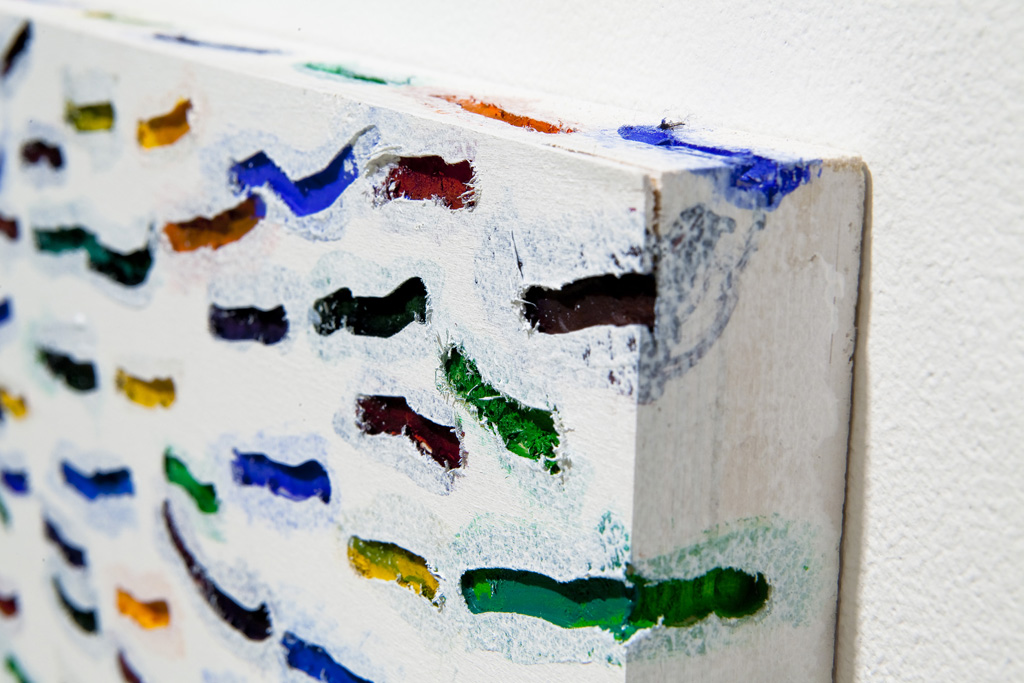PULSE 2009

Pulse (1 x 4), 2009, acrylic on wood, 48” x 48”
Line Dance, 2009, acrylic on routered wood, 68” x 112”

Pulse (1 x 4), 2009, acrylic on wood, 48” x 48”
Line Dance, 2009, acrylic on routered wood 68” x 112”

Line Dance, 2009, acrylic on routered wood 68” x 112”

Line Dance (detail), 2009, acrylic on routered wood 68” x 112”

Line Dance (detail), 2009, acrylic on routered wood 68” x 112”

Migration (1 x 3), 2009, acrylic on wood, covers 300 sq.ft.,dimensions variable

Line Dance, 2009, acrylic on routered wood 68” x 112”
Migration (1 x 3), 2009, acrylic on wood, covers 300 sq.ft.,dimensions variable

Line Dance, 2009, acrylic on routered wood 68” x 112”
Migration (1 x 3), 2009, acrylic on wood, covers 300 sq.ft.,dimensions variable

Migration (1 x 3), 2009, acrylic on wood, covers 300 sq.ft.,dimensions variable
Boogie (prototype), 2009, acrylic on routered wood, 12” x 48”
Stitched Lines (1x 3), 2009, acrylic on canvas, 93” x 88”

Boogie (prototype), 2009, acrylic on routered wood, 12” x 48”
Stitched Lines (1x 3), 2009, acrylic on canvas, 93” x 88”

Boogie (prototype) (detail), 2009, acrylic on routered wood, 12” x 48”

Boogie (prototype), 2009, acrylic on routered wood, 12” x 48”
Stitched Lines (1x 3), 2009, acrylic on canvas, 93” x 88”

Flight, 2009, acrylic on wood, 11” x 11”

Light Lines, 2009, acrylic on wood, 11” x 11”
Mathematical Relationships and ‘Counts’
N Numbers and proportions play a subtle but important part in creating cohesion in this exhibition. In each work there is repetition of a single linear unit and an action (routering, stitching or gluing) until a point is reached when there seems to be enough repetition. Sometimes ‘enough’ is quite a lot. This repeating of one thing over and over and over again conceptually joins one work to the next. There are mathematical relationships crisscrossing the room from one work to the next as well.
For example ...
There are 56 pieces of painted canvas sewn to the large canvas tarpaulin Stitched Lines (1 x 3). Each line measures 2” x 6” (a one by three ratio). The same size and format of line is used for all 218 raised wooden pieces in Migration (ie. 2” x 6” each).
There are 56 pieces of painted wood glued to the 4’ x 4’ square wooden surface of Pulse (1 x 4) but here each line measures 1” x 4” (a one by four ratio). This one by four ratio is in evidence in every other work in the room.
Boogie, the black routered work, measures 1’ x 4’. This work was a joy to make because ‘enough’ was a mere 310 routered lines thanks to a new chubby router bit..
Line Dance, the white routered work, is an amassing of eight units each measuring 14” x 56” (a one by four ratio). Each unit was routered 600 times for a total of 4800 lines in the work, most of which were painted twice. This work took several weeks to complete.
On each of the small works, Flight and Light Lines, there are 44 lines measuring .25” x 1” (the one by four ratio again). These 44 lines placed end to end would measure four times the length of one side. (Both the small works measure 11” x 11”).
Colours and Values - Playing with Perception
E Efforts have been made to bring about cohesion through the use of colour as well. The palette is northern, specifically from nature in the fall in southern Ontario on days when there is a mix in the sky of sunshine and blue-black storm clouds. These colours aren’t straight-from-the-jar bright. They are very strong, but more subdued and more subtle than the colours of the chemist. Our nature’s colours are made by mixing. In painters’ terms, they are grayed. Put a bit of navy in the orange or red in the green or purple in the yellow and it starts to happen. If vestiges of the bright colours are left behind, these grayed colours start to dance in just the way the colours dance on one of those perfect fall days. In two of the works (Pulse (1x4) and Migration (1x3)) a tight range of values on grey scale - somewhere below middle value and moving toward black - has been chosen and all of the colours have been mixed to be within this tight range. Because of this the works look dark grey and white at first. The colours reveal themselves, slowly. Lighting has been used to enhance this effect.
Illusions and Realities
I In each of the works, the repeated lines are directional. Thus the viewer’s eye is carried from one line to the next - either up and down or side to side - in an endless and ongoing manner. There is an illusion of movement.

Line Dance, detail 2009, acrylic on routered wood 68” x 112”

